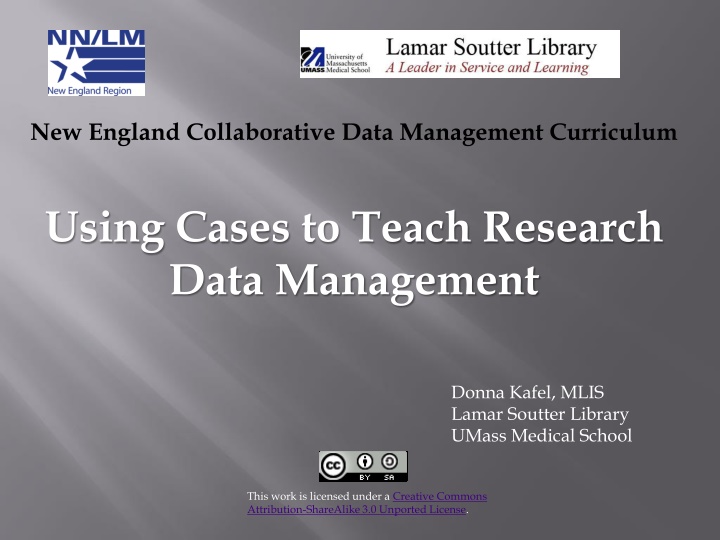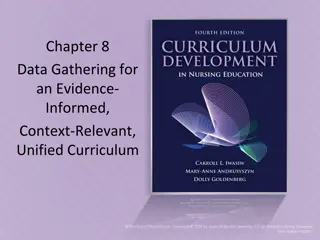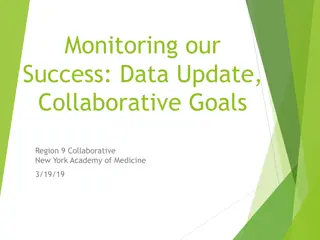New England Collaborative Data Management Curriculum
Utilizing real-world cases, the curriculum teaches research data management concepts across various disciplines such as clinical health, biomedical labs, qualitative behavioral studies, and engineering tests. Each case study provides teaching points, discussion questions, and activities to illustrate key research data management concepts in lesson plans.
Download Presentation

Please find below an Image/Link to download the presentation.
The content on the website is provided AS IS for your information and personal use only. It may not be sold, licensed, or shared on other websites without obtaining consent from the author.If you encounter any issues during the download, it is possible that the publisher has removed the file from their server.
You are allowed to download the files provided on this website for personal or commercial use, subject to the condition that they are used lawfully. All files are the property of their respective owners.
The content on the website is provided AS IS for your information and personal use only. It may not be sold, licensed, or shared on other websites without obtaining consent from the author.
E N D
Presentation Transcript
New England Collaborative Data Management Curriculum Using Cases to Teach Research Data Management Donna Kafel, MLIS Lamar Soutter Library UMass Medical School This work is licensed under a Creative Commons Attribution-ShareAlike 3.0 Unported License.
Discipline Research setting (e. g. clinic, lab) Specific data management concept or issue
New England Collaborative Data Management Curriculum Cases Clinical Health Study: Outcomes from Orthopedic Implant Surgery Studying Vitamin D as an Augmentation of Treatment for Bipolar Depression Health Study in lab: Combining Data from 10 Years of Research for Retrospective Studies on the Effects of Exercise and Diet on the Risk of Diabetes 2/24/2025
New England Collaborative Data Management Curriculum Cases (cont d) Biomedical lab: Regeneration of Functional Heart Tissue in Rats Qualitative Behavioral Health Study: Improving End of Life Care in African Americans Engineering Test Lab: Characterizing a Component of a Rocket Engine Used to Control Satellites in Orbit
New England Collaborative Data Management Curriculum How to teach RDM using cases Summary of teaching points preceding each case Discussion questions following each case Research Data Management Concepts and Issues Illustrated in the Teaching Cases Integrated as activities in lesson plans
Case Analysis using Simplified Data Management Plan 1. Types of data 2. Contextual details (metadata) needed to make data meaningful to others 3. Storage, Backup, and Security 4. Provisions for Protection/Privacy 5. Policies for re-use 6. Policies for access and sharing 7. Plan for archiving and preservation of access
UK Data Archive Research Data Lifecycle http://www.data-archive.ac.uk/create- manage/life-cycle
Image courtesy of UC Davis College of Engineering A data management case study in biomedical engineering research
Photo from Bureau of Labor Statistics. Advances knowledge in engineering, biology, and medicine, and improves human health through cross-disciplinary activities that integrate principles of engineering sciences with medical sciences and clinical practice. 3 3Imperial College London. N.D. http://www3.imperial.ac.uk/pls/portallive/docs/1/51182.PDF
Experiment: delivery of stem cells on a biological fibrin microthread to areas of damaged heart tissue in one rat s heart Purpose: to restore mechanical function of damaged heart tissue Image courtesy of Dr. Glenn R. Gaudette
SDMP # 1 creating data Photo courtesy of nlm.nih.gov Photo courtesy of Dr. Glenn R. Gaudette
Animal Model for Experiment: Rat SDMP # 1 creating data SDMP # 2 File formats
SDMP #1 Creating data -2 days: Incubate stem cells with markers -1 day: Stem cells in solution with biological suture 0 day: #1 Surgery: infarct/delivery of stem cells to damaged heart tissue 7 day: #2 Surgery: examination, high speed imaging/LVPs, isolate heart and place it in freezer 8 days +: Section heart, tissues on slides, staining, images of tissues, tracking particles on heart Collective data from experiment
Timeline of Experiment SDMP #1 Creating data 2 days before surgery 1 day before surgery Incubate adult stem cells with markers (Q dots) Place stem cells in solution inject into tube with biological suture Images courtesy of Dr. Glenn R. Gaudette
Timeline of Experiment Day of Surgery DMP #1 Creating data 1. Document pre-op data 2. Operative procedure: open up thoracic cavity. a. Create a myocardial infarction b. Place biological suture with stem cells in area of infarct (damaged heart tissue) document operative data DMP #4 Ethical issues Image courtesy of Dr. Glenn R. Gaudette
Timeline of Experiment DMP #1 Creating Data 7 Days Post Stem Cell Delivery: 2nd surgery 1.Thoracic cavity is reopened 2.Images of heart are collected with 2 cameras 3.Pressure transducer syncs with images measures left ventricular pressure 4.Euthanize rat 5. Isolate heart and fix it in a fixative 6. Put in freezer 24 hrs. DMP #2 Formats, Naming DMP #3 Storage Image courtesy of Dr. Glenn R. Gaudette
Timeline of Experiment SDMP #1 Types of data 24 hours after placement of heart in freezer: Sectioning heart tissue SDMP #2 Contextual Data 1. Cutting sections of heart and placing on slides. (Yield ~200 slides per experiment) 2. Tissues are kept in 3 freezers. SDMP #3 Storage. Security
Timeline of Experiment 8+ Days: (up to a couple months): SDMP #1 Creating Data 1. Some of the slides are stained immediately 2. Other slides stained from a day to a couple of months after that 3. Stains: some are stained with trichrome, some other stains for specific markers SDMP#2 Contextual Details ~200 slides SDMP #3 Storage Image courtesy of Dr. Glenn R. Gaudette
Timeline of Experiment Unspecified but after several slides are stained: Taking microscopic images of stained slides Take images on lab s epifluorescent microscope SDMP #3 Storage Security SDMP #1 Creating data If happy with staining, use confocal microscope to take better quality images SDMP #2 File formats Naming conventions
At the same time. Team looks at the data that they acquired and use home-grown software to track particles on the surface of the heart to see how far and how fast those particles are moving. SDMP #4 Ownership SDMP #3 Storage SDMP #1 Creating data
File Formats Data File Format SDMP #3 Storage Images Left ventricular pressure measurements ? ? SDMP #2 File formats Home made software MATLAB or C Histology sections Slides file name based on stain example .act is actinin stain SDMP #4 Ownership Contextual Paper lab notebook, animal log Directory that links data sets together: Excel spread sheet
Analyzing the data There could easily be up to 10 people involved in data analysis and we have not yet found a good way to link all the data. Dr. Glenn R. Gaudette, PI
Data Set Storage SDMP #3 Storage, Backup, Security Optical images taken during Surgery: (~10,000 images) 1000 images for each data set Left ventricular pressures (numeric) correlating with specific images Tissue sections Hard drive acquisition computer > Drobo backup>hard drive of network computer backed up by institution Same as above Slide boxes could be in any of 3 or 4 freezers ? Software Images from different stained tissue after second surgery Drobo > DVD backups Contextual data Paper lab notebook (lab, PI s office), surgical log (with animal)
SDMP #7 Plan for archiving & preservation of access DMP #4 Ethical issues SDMP #6 Policies for Access and sharing SDMP #5 Policies for reuse What are the policies for reuse of data? What is the process for gaining access to data? What is the long term plan for preservation and maintenance of the data?
Case B Analysis using Simplified Data Management Plan 1. Types of data: Images of heart, LVP measurements, histology slides (tissues), images of slides, software 2. Contextual details (metadata) needed to make data meaningful to others: experiment # dates of experimental activities stem cell line details about animal (species, age, identifier) area of infarct area where stem cells implanted type of stain used instrumentation 3. Storage, Backup, and Security: Hard drive of acquisition computer (initial) Drobo networked hard drive (backed up by institution) DVDs Slide boxes in freezers
Case B Analysis using Simplified Data Management Plan 3. (continued): Lab notebooks/animal surgical logs (some backup when data is transcribed from animal surgical log to paper lab notebook) 4.Provisions for Protection/Privacy: Files are not password protected Paper lab notebooks are kept in lab/older ones in PI s office (key card access to these rooms) 5.Policies for re-use: Not addressed need to ask researcher (possiblities: reuse with permission of PI, institutional policies) 6.Policies for access and sharing: Not addressed need to ask researcher (possibilities: PI will make accessible after paper publication, will share them immediately, may depend on funding agency reqs. 3.
Case B Analysis using Simplified Data Management Plan 7. Plan for archiving and preservation of access Not addressed ask researcher (possibilities: convert files in proprietary formats to generic formats, appraisal of data and data versions, decision on where data should be archived (IR or DR)
Gaudette, G. R. 2011. Keeping a lab notebook in the Gaudette lab. Unpublished. Gaudette, G. R. 2012. Data management in biomedical engineering: needs and implementation. Power point presentation. University of Massachusetts Medical School, Shrewsbury, MA 4 April 2012. http://escholarship.umassmed.edu/escience_symposium/2012/program/9/ Gaudette,G.R. and Kafel, D. 2013. A case study: data management in biomedical engineering. Journal of eScience Librarianship: 1(3): 159- 172. http://dx.doi.org/10.7191/jeslib.2012.1027 Humphries, C. 2003. e-Science and the lifecycle of research. Accessed March 19, 2013 at datalib.library.ualberta.ca/~humphrey/lifecycle-. science060308 Imperial College London, Department of Engineering. N.D. Definition of biomedical engineering. Accessed March 20, 2013 at http://www3.imperial.ac.uk/pls/portallive/docs/1/51182.PDF UK Data Archive. Research Data Lifecycle. http://www.data- archive.ac.uk/create-manage/life-cycle























